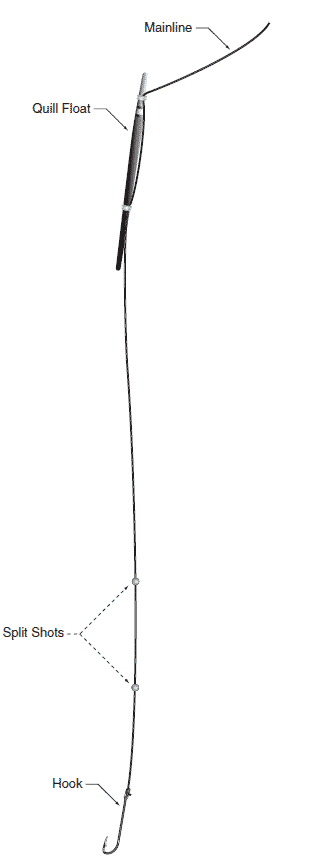Download our Knot Book!!!
RIGS
Running Sinker Rig
This rig has many uses in both freshwater and marine fishing. It can be used to catch snapper, whiting, flathead and bream in saltwater, and trout, redfin, carp, golden perch and Murray cod in freshwater.
The rig consists of a sinker threaded onto the mainline above a swivel, with a length of trace line then leading down to a hook.
One type of knot, such as a locked half blood, or a clinch knot, can be used to tie the entire rig. This is perhaps the most commonly used rig in fishing. As a general rule the sinker should be kept as small as possible, as long as it enables the angler to make a suitable cast. The swivel should also be kept small. The trace line is usually about 40 to 50 centimetres long.
The size of the hook is governed by the type and size of bait that will be used, as well as the type of fish that the angler expects to catch. The most commonly used sinker in this rig is a ball sinker. Swivels should always be used when fishing. They provide a way of joining the trace to the mainline, stop the sinker from sliding down to the hook, and also prevent your line from twisting.
RIGS
Paternoster Rig
This rig is mainly used in saltwater fishing. The easiest way to tie this rig is using a three-way swivel as shown in the diagram. The paternoster rig allows the bait to be presented above the sinker, so that the bait is lifted a short distance above the bottom.
The rig can be tied as a single paternoster as shown in the diagram, or as a double paternoster, which requires the use of two swivels and two hooks. The advantage of a double paternoster rig is that two different baits can be presented at the same time.
A single knot such as the locked half blood or clinch knot, can be used to tie the entire rig.
The type of sinker to be used with this rig is normally a bomb or star sinker, both of which have a swivel embedded at their top end.
This rig is used mostly when fishing off a beach, but can be used in many other saltwater situations. For example it can be very effective when fishing for mullet and flathead in bays and estuaries. At times this rig can also be effective in freshwater fishing.
Sinkers can either be running (with a hole) or fixed (with a swivel). They help your baited line to sink down to the bottom and heavy sinkers also allow you to cast further. They come in many different shapes and sizes.
RIGS
Quill float and bob float
A rig with a float is used to present a bait near the surface of the water, rather than on or near the bottom, which was the case with the previous two rigs.
A quill float is attached to the line with plastic bands, or there may be an eyelet at the bottom of the float to thread the line through.
A bob float, which is usually red and white in colour, is attached with wire clips located at the top and bottom of the float. The top of the float is pressed down to open the clips and the line is threaded through.
With both types of floats the distance between the float and the bait can be easily adjusted, and may vary between 50 cm to 2 metres or more.
Between the float and the hook, split-shot sinkers can be added to the line to make sure that the bait sinks down away from the float. This may be especially important when the bait is very small, or when there is a current in the water, such as in a river or out at sea.
This rig can be used to catch several species of fish in freshwater and is a must when fishing for garfish in marine waters.





